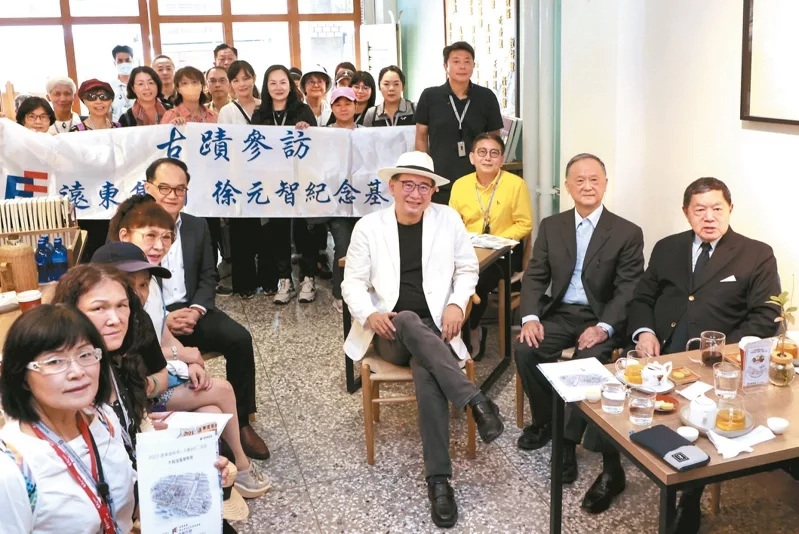The Far Eastern Architecture Award recently hosted the "Historic Site Visiting Part Two - Reappearance of Dadaocheng," a captivating event that brought together dozens of participants for an immersive exploration of the century-old charm of Dadaocheng. Renowned scholars and experts, including Executive Yuan Culture Award winner Li Qianlang and the acclaimed "Architectural Detective" Li Qingzhi, enriched the experience with lectures and guided tours.
FEG Chairman Hsu, a distinguished attendee, reflected on his own connection to Dadaocheng, recalling that half a century ago, he entered the opulent mansions of affluent merchants in the area as a "salesman." He fondly praised the enduring allure of Dadaocheng, stating that "the splendor of Dadaocheng has never disappeared." Emphasizing the profound historical significance, he asserted that the old streets and markets epitomized by Dadaocheng constitute an integral part of Taiwan's cultural DNA. In his view, preserving these cultural treasures is not just a responsibility but a necessity for safeguarding Taiwan's heritage.

FEG Chairman Douglas Tong Hsu (far right) also attended the tour. Photo By Reporter Huang Yishu
As the Far Eastern Architecture Award marks its 25th year, the commitment to fostering breakthroughs and innovations in architecture remains unwavering. In collaboration with Far Eastern Department Stores, the initiative has successfully continued its efforts. Last year witnessed the inaugural event of the historical heritage visit at the Taipei Confucius Temple and Taipei Baoan Temple, drawing the participation of nearly 600 individuals.
Building on this success, the Far Eastern Architecture Award has extended its impact with the second part of the "Historic Site Visiting Month" this year. With a total of 16 sessions, the program has attracted the active engagement of over 500 participants. This initiative provides a unique opportunity for individuals to embark on personal visits, offering an immersive experience to explore and appreciate the beauty of Taiwan's traditional architecture. Through these initiatives, the Far Eastern Architecture Award serves as a catalyst for enriching public understanding and appreciation of the architectural heritage that contributes to the cultural tapestry of Taiwan.
As its name implies, Dadaocheng, originally a grain drying farm, began its development in the middle and late Qing Dynasty. A significant event known as the "suburban fight" compelled defeated immigrants from Tong'an, Fujian Province, to migrate to Dadaocheng from the Menga area. The strategic advantage of river navigation further contributed to the prosperity of Dadaocheng. In contrast to the conservative stance of the Monga area, Dadaocheng embraced a more inclusive approach, welcoming foreign influences. This openness resulted in the establishment of foreign banks and the presence of foreign consulates. Notably, Taiwan's first governor, Liu Mingchuan, officially designated Dadaocheng as a commercial district and a residence for foreigners. To enhance the area's appeal, Liu invited wealthy individuals such as Lin Weiyuan and Li Chunsheng to invest in the construction of foreign-style buildings, giving rise to Taipei's inaugural foreign-style building street. Dadaocheng quickly became home to prominent institutions, including the U.S. Consulate and foreign-owned companies like Tait Marketing & Distribution Co., Ltd., and Jardine Matheson, establishing itself as a hub for international trade and cultural exchange in Taipei.
Under the guidance of Lin Jiashu, the grandson of "Taiwan Heritage God" Lin Hengdao, also an expert in heritage tour guides, the public embarked on a fascinating exploration of historical sites. The tour included visits to notable Western-style buildings such as Watsons Pharmacy, Li Chunsheng Memorial Church, and Chen Tianlai's former residence. Additionally, participants had the opportunity to explore cultural gems like the Xiahai City God Temple and Dadaocheng Cisheng Temple, where master craftsman Chen Yingbin's works were showcased. During the tour, Li Qianlang remarked on the unique architectural features of Dadaocheng. He noted that, unlike the buildings on the Bund in Shanghai, which were constructed by European architects, the Western-style buildings in Dadaocheng were built by local craftsmen based on images of Western architecture. The exteriors exude a distinctly foreign flavor, while the interiors retain the authentic layout of traditional Chinese houses. This blend of Western aesthetics and traditional Chinese design creates a captivating and harmonious architectural tapestry in Dadaocheng.
Chairman Hsu reminisced about the 1970s when, at less than 30 years old, he frequented Dadaocheng to promote FEG products. During that era, Dadaocheng was home to significant financiers, and Hsu vividly recalled the challenges of navigating this bustling business hub. He disclosed that, at the time, he relied on informants to gauge the mood of financiers, strategically determining the optimal moments for door-to-door sales. This approach allowed him to penetrate the residences of affluent merchants and explore the extensive and labyrinthine interiors of Dadaocheng street houses. Adding historical context, Tamkang University Emeritus Professor Zhou Zongxian highlighted that numerous major corporations in Taiwan, including Guangquan, Yakult, Yimei, Taifeng, Uni-President, and others, had established a presence in Dadaocheng at some point in time. This underscores the historical and commercial significance of Dadaocheng as a vibrant hub for business activities and trade in Taiwan.